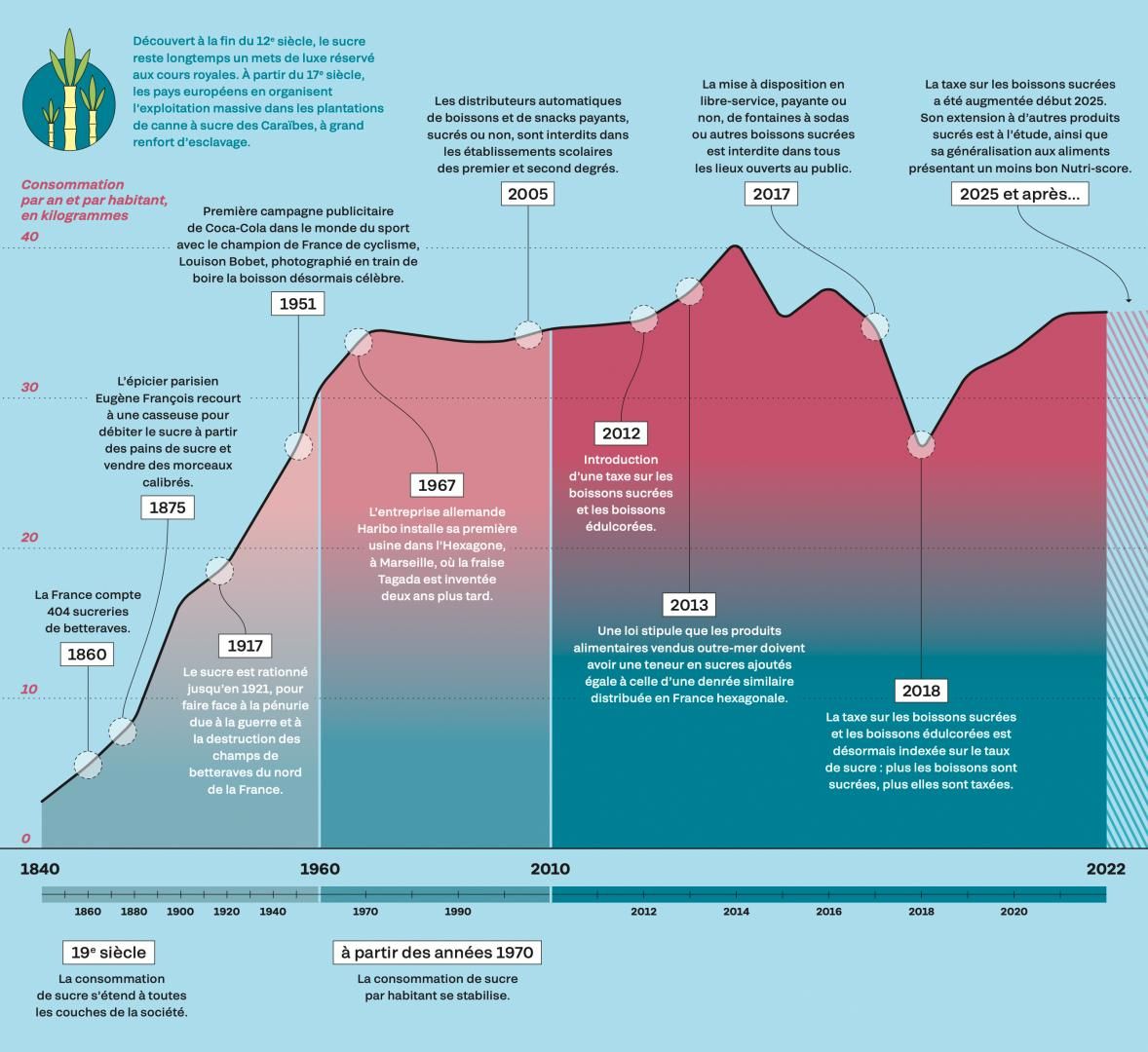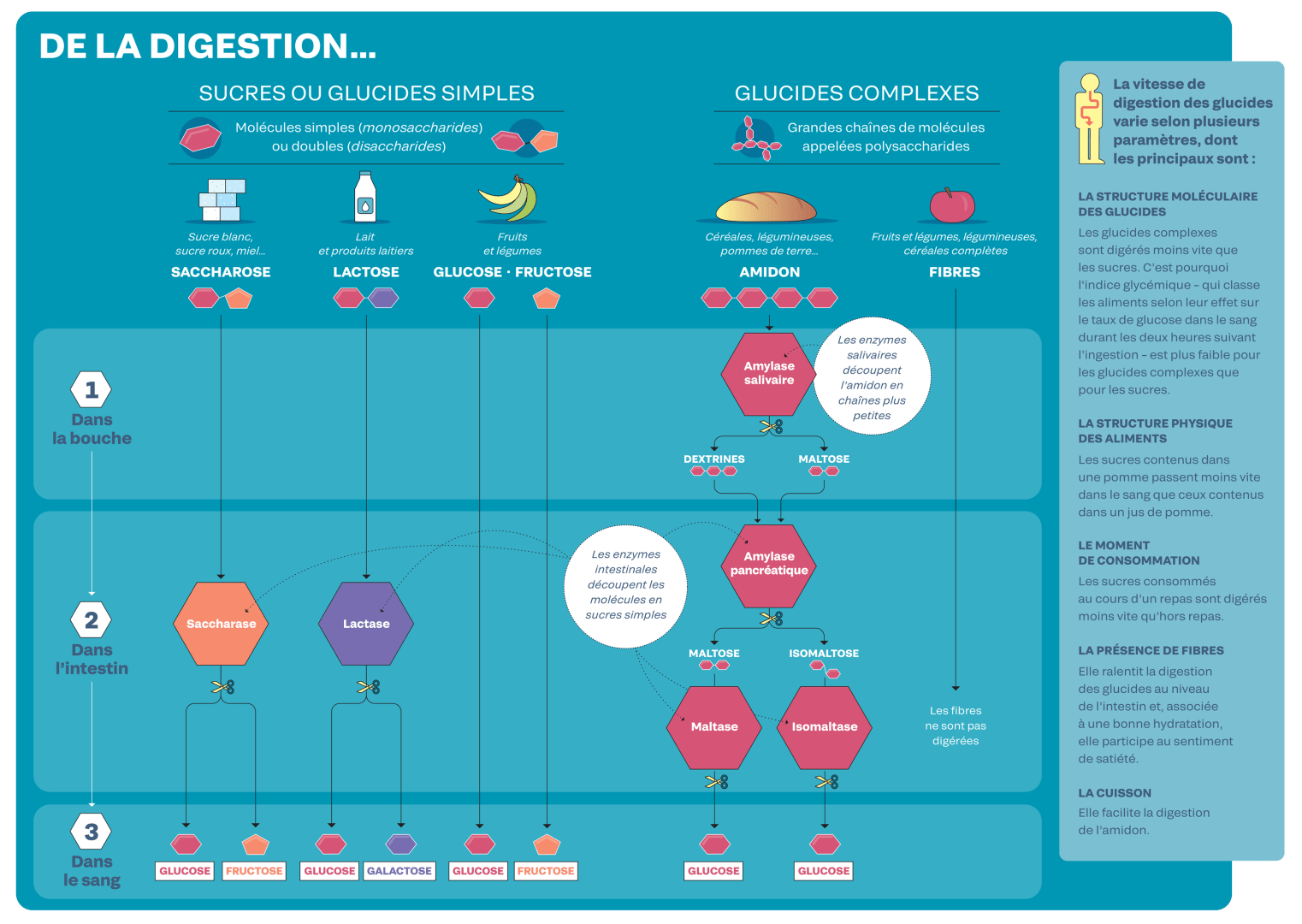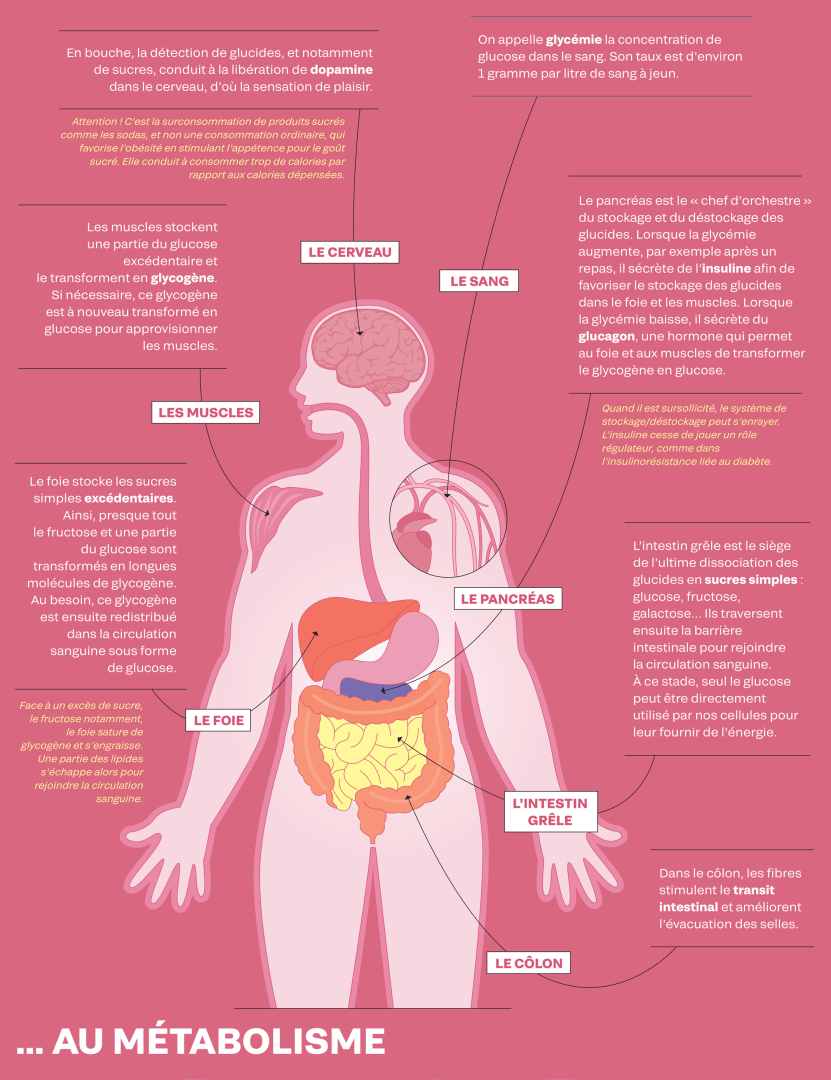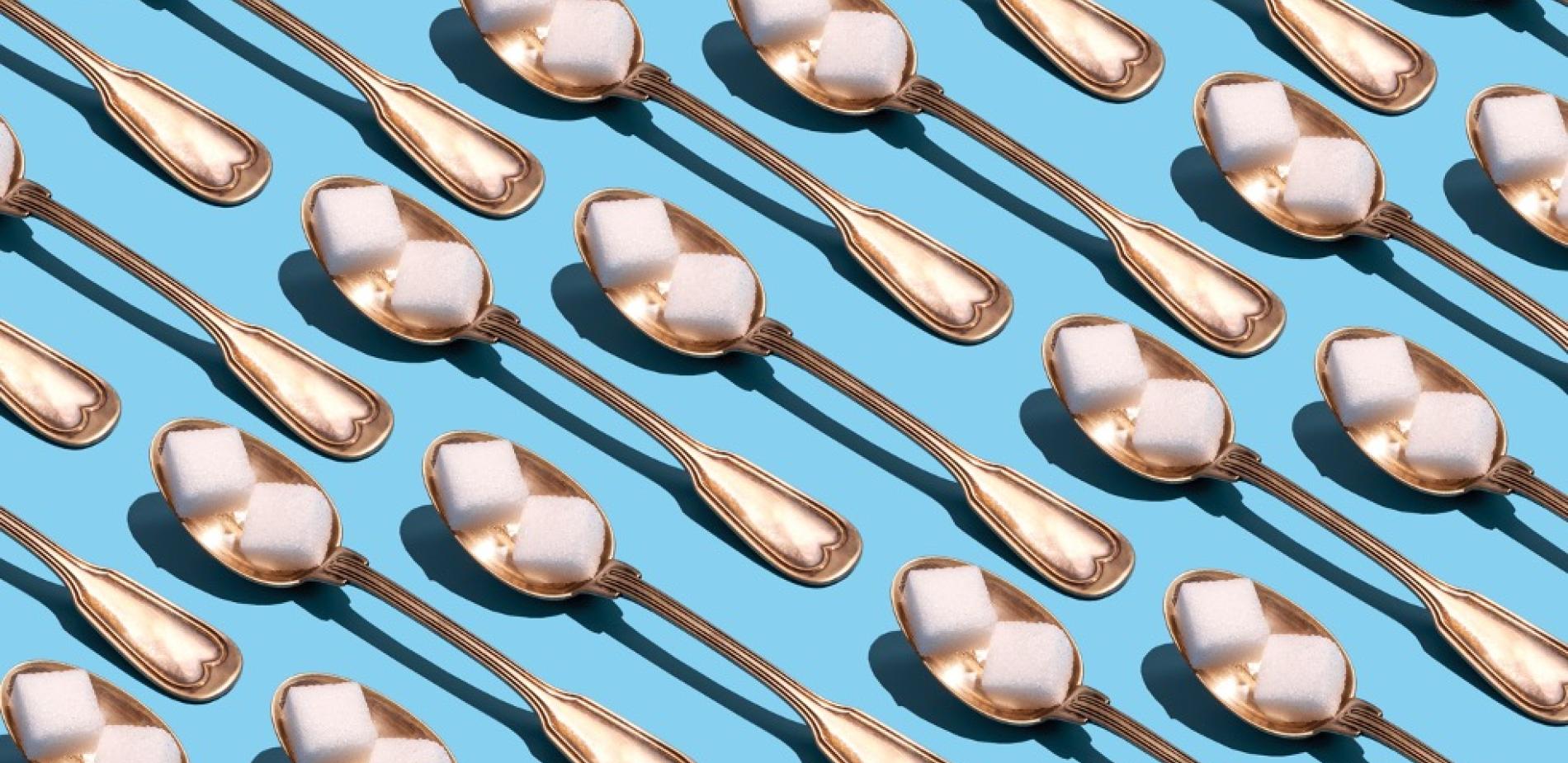
Sugar everywhere : something to be salty about!
In yogurts and biscuits, even pizzas and industrial ham: sugar is everywhere. So, can we do without it? Is this delectable ingredient really as bad as all that?
Investigation by Alexandra Pihen, with students from the Lille School of Journalism (ESJ) - Published on
Enough already!
Tinned peas, pesto, mayonnaise, crackers… 85% of processed products contain added sugar! And it’s usually the cheapest products that contain the most, according to an investigation by the association Foodwatch in five major French supermarket chains, whose findings were published in January 2025.
This is alarming, as sugar consumption in France and elsewhere exceeds recommended levels. One quarter of adults and adolescents, 60% of 8-12 year olds and three-quarters of children aged 4 to 7 eat too much sugar. To steer consumers away from sugar and urge manufacturers to improve the ingredients in their products, in 2012 France introduced a tax on sugar-sweetened and artificially-sweetened beverages. Since 2018, this has even been indexed to the quantity of added sugar. In theory, this tax should have reduced annual sugar consumption per capita by 2 kilograms, thus preventing nearly 700 deaths a year. But its effectiveness has been limited. So in February 2025, it was significantly increased: it has now doubled on drinks containing the most sugar, with expected tax revenues of €800 million. Some thirty countries worldwide also tax products containing sugar.
Despite this, researchers advocate for a combination of financial and regulatory measures. Since January 2018, France has thus banned any advertising during programmes intended for under 12s on national television. Meanwhile, in autumn 2025, the UK plans to introduce a 9pm restriction on TV ads for foods high in sugar, salt, and fat.
Sugar consumption has remained steady since the 1970s
Sugar consumption trends have been stable in France since the 1970s. We’re referring to 'simple sugars'—those found in food and processed products, such as brown or white sugar from sugar beets or cane, honey, and naturally occurring sugars in fruits, vegetables, and dairy products. For the time being, regulatory measures have not succeeded in bringing about a lasting reduction in our sugar consumption.
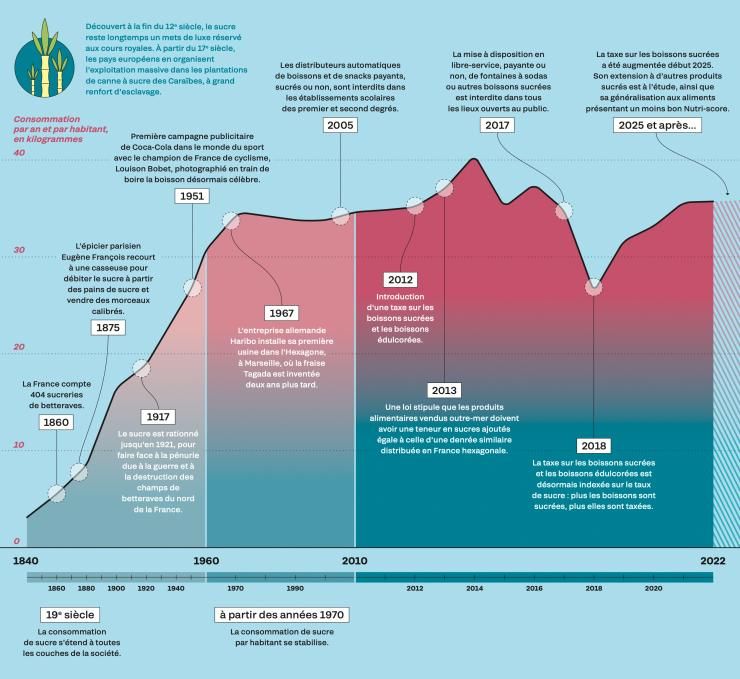
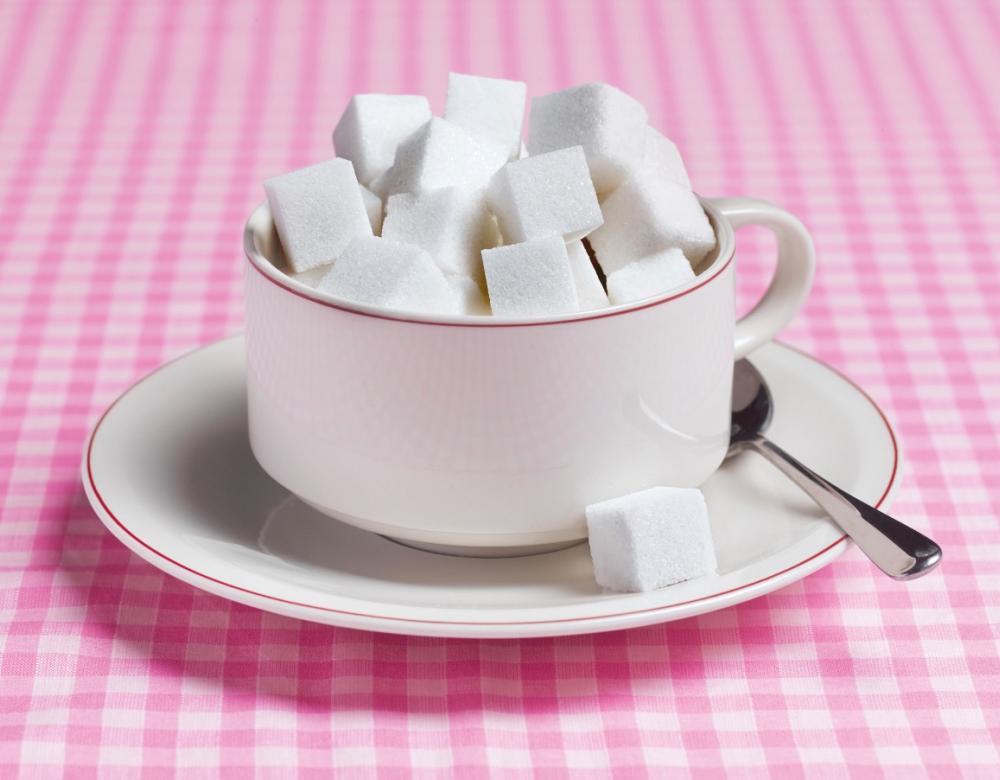
Can sugar become an addiction?
The more we eat, the more we crave it! Sugar consumption can lead to addictive behaviours, when our taste receptors are over-stimulated and activate the regions of our brain associated with reward, motivation and motor control. Stress, anxiety, irritability: the symptoms that manifest when sugar intake suddenly stops are physically noticeable. However, they are usually mild and short-lived, unlike withdrawal symptoms from alcohol or opioids. And excessive consumption does not lead to intoxication, either. So specialists prefer to talk about ‘mild dependency’, similar to what can develop with regular coffee consumption.
What kind of sugar are we talking about?
There are different types of carbohydrates - the nutrients that break down into glucose in our bodies - and it isn't easy to tell good from bad! But it’s actually fairly straightforward, as there are two main categories of carbohydrates, based on their molecular structure.
Simple carbohydrates, or ‘sugars’, contain one or two molecules, hence their name. These are what scientists are interested in and what nutritionists are concerned about. They are found in table sugar, sucrose, which combines a glucose molecule and a fructose molecule, and therefore in all food and drink containing added sugar. They are also naturally occurring in fruit and vegetables in the form of glucose and fructose, as well as in milk and dairy products which combine glucose and galactose. Complex carbohydrates, meanwhile, are made up of molecules strung together in very long chains. They occur in the form of starch in grains, pulses and potatoes. They are called ‘slow sugars’ as they take longer to digest.
Sugar and starch are broken down by our digestive system into single molecules which are absorbed into the bloodstream in the small intestine. Their digestion depends on various factors: when they are consumed (during a meal or not), how they are cooked and whether or not there is fat or dietary fibre present too.
In all cases, carbohydrates are involved in vital metabolic processes, the main one being to supply our bodies with energy. The absorption of glucose into the bloodstream maintains a constant blood sugar level: normal fasting blood glucose levels are around 1 gram of glucose per litre of blood.
Glucose, our body’s main fuel source
Carbohydrates are found in almost all kinds of food, and are essential for the healthy functioning of our body. According to nutritional guidelines, they should account for half of our daily energy intake. They supply a complex metabolism which breaks them down into glucose, the energy source that our cells, muscles and brain need.
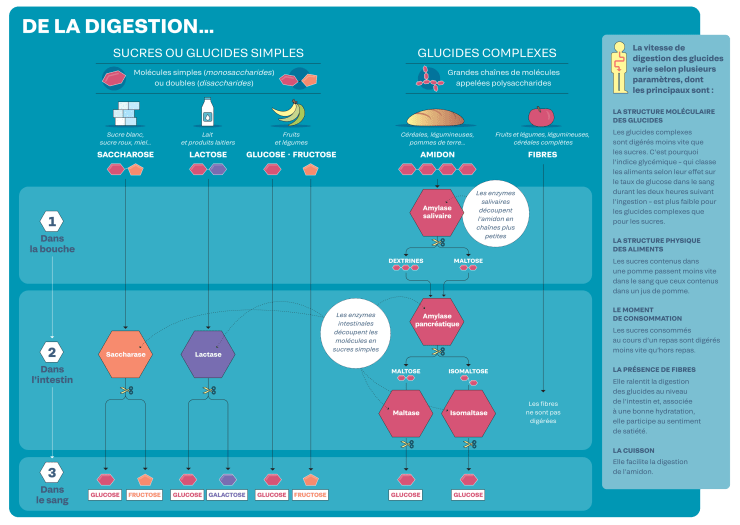
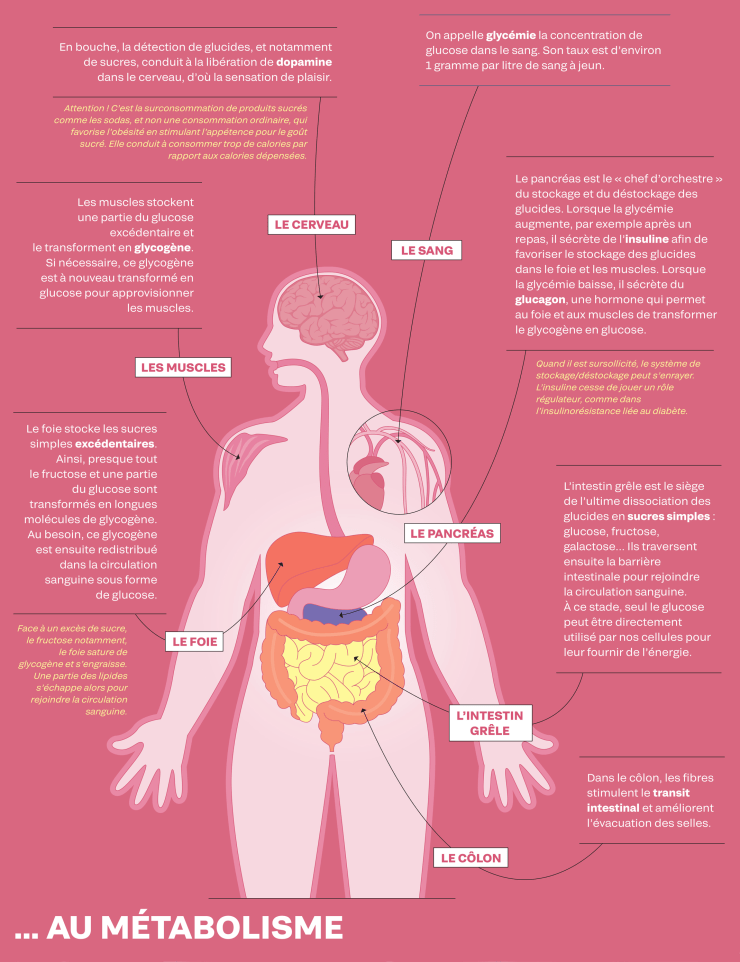

What's wrong with a blood sugar spike?
Drink vinegar before a meal, start with vegetables... Here are some ‘nutritional tips’ given by French influencer Jessie Inchauspé and her Glucose Goddess method to avoid blood sugar spikes which are considered bad for our bodies. Bad? Be careful not to ‘pathologise a natural physiological reaction!’ warns Inserm (French institute dedicated to biomedical research and human health). After a meal, it’s natural for blood sugar levels to rise: in a healthy, non-diabetic person, the hormone insulin regulates the level of sugar in the blood, by storing excess glucose in the liver or muscles.
Beware of too much sugar in childhood
Published at the end of 2024 in the academic journal Science, a historic study confirms the risks of too much sugar in early childhood. Drawing from a vast medical database, it compares the health trajectories of 60,000 people born between 1951 and 1956 in the UK. Until September 1953, sugar was rationed in the UK, to about 40 g per person per day, the equivalent of eight sugar cubes. The rationing was lifted after that date and, by the following year, sugar sales had doubled.
The result? The risk of developing type 2 diabetes and high blood pressure in adulthood was 35% and 20% less respectively in toddlers subject to sugar-rationing until age 2, compared with children who were not. Moreover, the average age of onset of these two diseases was four and two years later respectively in sugar-rationed infants. Another significant finding is that sugar rationing during pregnancy would seem to lower the risk by about a third.
Other studies confirm the link between sugar and various health issues, including tooth decay and cardiovascular diseases such as aneurysms. Fructose, found in fruit juice and added to soft drinks, can contribute to fat accumulation in the liver, leading to liver disease. Eating too much sugar is also believed to reduce the amount of some immune cells essential for protecting our bodies against infection. Finally, excess weight, obesity (affecting 1 in 8 people worldwide), and type 2 diabetes (1 in 10) have reached epidemic proportions globally.
The cancer risk
Excessive sugar intake can disrupt metabolism, leading to insulin resistance, obesity, and inflammation—factors that increase cancer risk. Intended to study the links between nutrition and health, the French study NutriNet-Santé thus confirms, in a cohort of 100,000 people, the link between an excessive consumption of sugar-sweetened food and drink and a higher risk of cancer, especially breast cancer, irrespective of any weight gain. The exact mechanisms are not yet clearly understood. After a cancer diagnosis, there’s no need to completely give up sugar, however! What matters is to eat a balanced diet.


Too much sugar is bad for the brain
Although it needs some to function, our brain suffers if we consume too much sugar. In August 2023, a study conducted on more than 200,000 people in the UK thus found that sugar significantly increases the risk of dementia, including Alzheimer’s disease. Other scientific studies establish a causal link between too much sugar and depression. A diet that is low in sugar can, on the other hand, help to alleviate these symptoms. But this does not concern all neurodevelopmental disorders, and especially not attention deficit hyperactivity disorder (ADHD) in children.

Some sugar is ok, in moderation!
So should we simply be cutting all sugar out of our diet? The recommendations aren't that drastic - nor that simple! The French Agency for Food, Environmental and Occupational Health & Safety (Anses) recommends that adolescents and adults limit their sugar intake to 100 grams per day (not including milk and dairy products), which is the equivalent of one orange, one banana, one 50 g portion of sugar-sweetened breakfast cereal and one drink containing sugar (fruit juice or soft drink) in one day. For 8-12 year-old children, the recommended guidelines are 75 g/day (60 g/day for 4-7 year olds). Anses also gives a reminder that a diet with plenty of complex carbohydrates is enough to meet our glucose requirements.
For its part, the World Health Organisation (WHO) recommends limiting daily intakes of ‘free sugars’ to 25 g, or 5 sugar cubes: ‘free sugars’ refer to those added to food and drink, as well as those naturally occurring in honey, syrup and fruit juice.
Such amounts aren't easy to measure in everyday life, but the 5-colour nutrition label (Nutri-Score) on the front of food packaging can give us a helping hand: its score ranging from A to E gives us an idea of a product’s nutritional value at a glance. For comparable products, a high-sugar foodstuff would be rated D/E rather than A/B. A new algorithm, approved in 2024 by the Nutri-Score scientific committee, includes sweeteners and lowers the score of products containing added sugar. Once adopted, this will see sugar-sweetened milk-based drinks and breakfast cereals being attributed a worse score. These scores are already available on the QuelProduit app developed by the association UFC Que Choisir.
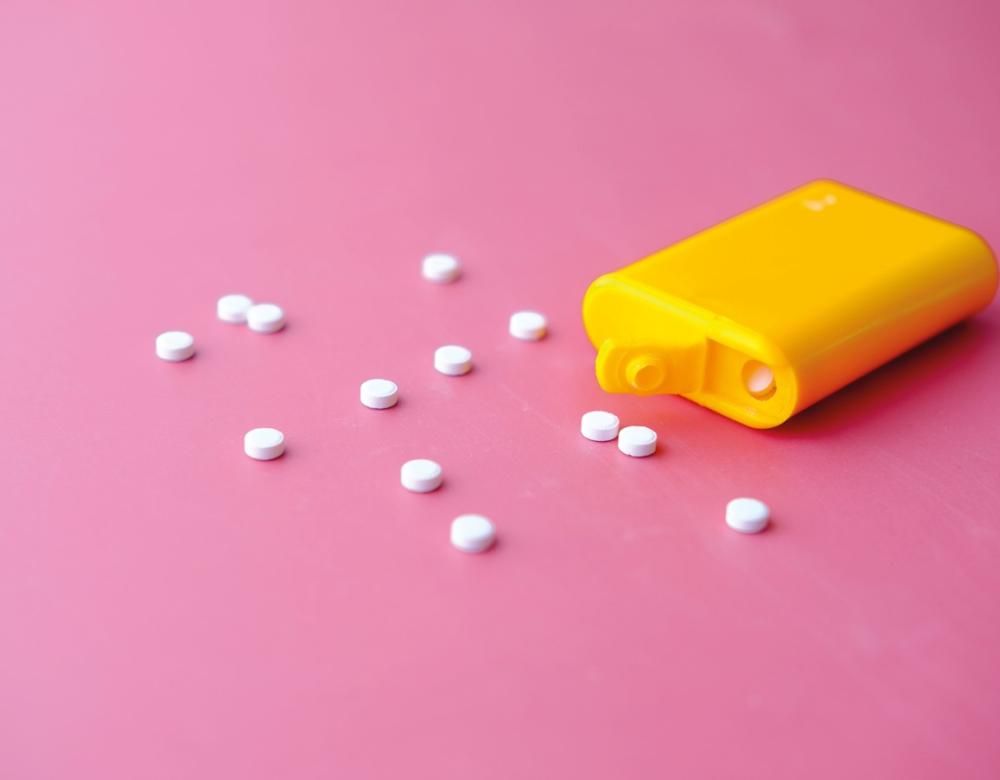
What about sweeteners then?
Aspartame, acesulfame K, stevia… It’s hugely tempting to replace sugar with sweeteners, which would retain all the taste without the calorie intake. But, since 2022, the World Health Organisation (WHO) has advised against this. On the one hand, there is no evidence that these substitutes genuinely help to control weight or blood sugar levels over the long term. And on the other, like sugars, sweeteners are associated with cardiovascular diseases and diabetes. Since 2023, WHO has even considered aspartame to be possibly carcinogenic. Scientists therefore reckon that the best way to limit our sugar intake is to gradually develop less of a sweet tooth.
Athletes, elite sugar eaters
A marathon runner uses up almost as much energy in one hour (750 to 1,500 kcal per hour) as a sedentary person does in one day (2,000 kcal). The metabolisms of elite athletes must therefore adapt to cater to extraordinary energy demands. Because the body’s usual glucose stores tend to run out after 90 minutes of sustained exercise, a few days before a competition an endurance athlete needs to eat more wholegrain foods, pulses and other complex carbohydrates to increase these stores. In this way, a professional athlete can train themselves to absorb twice the amount of glucose that an amateur athlete can absorb hourly (around 60 grams)!
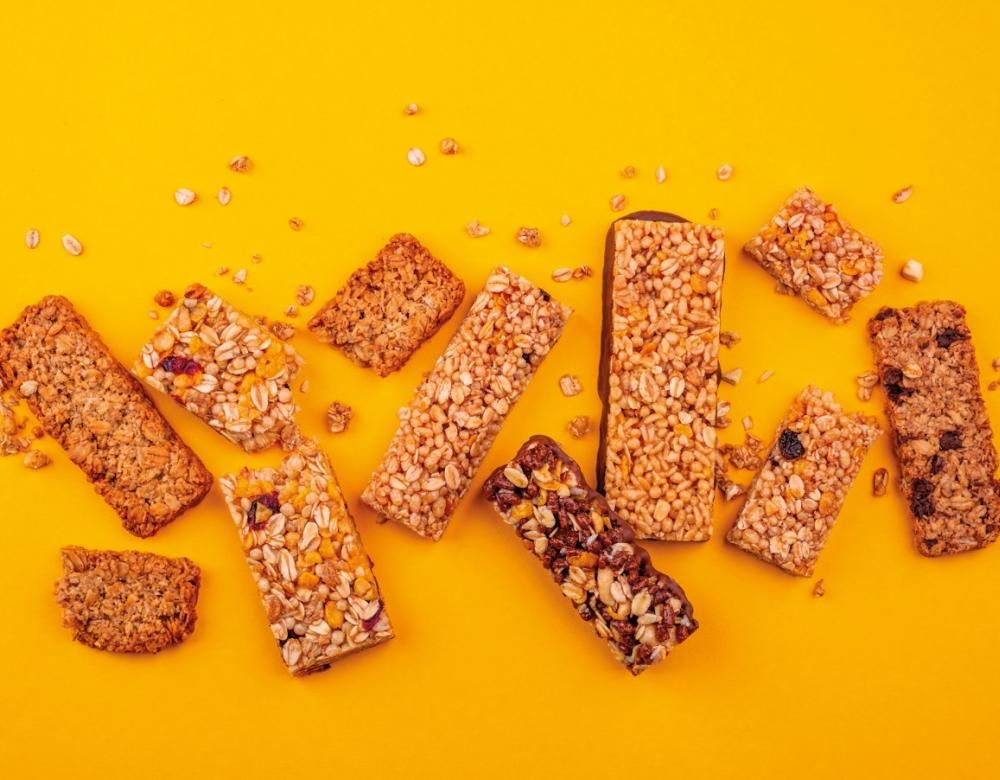
Science journalism students from the Lille School of Journalism contributed to this dossier : Anaëlle Charlier, Pierre Giraudeau, Esteban Grépinet, Charlotte Leduc, Florentin Lopacinski, Aurore Neyrat, Ugo Petruzzi, Théotim Raguet, Enola Tissandié, Josué Toubin-Perre, Louane Velten et Matteo Vivier.
